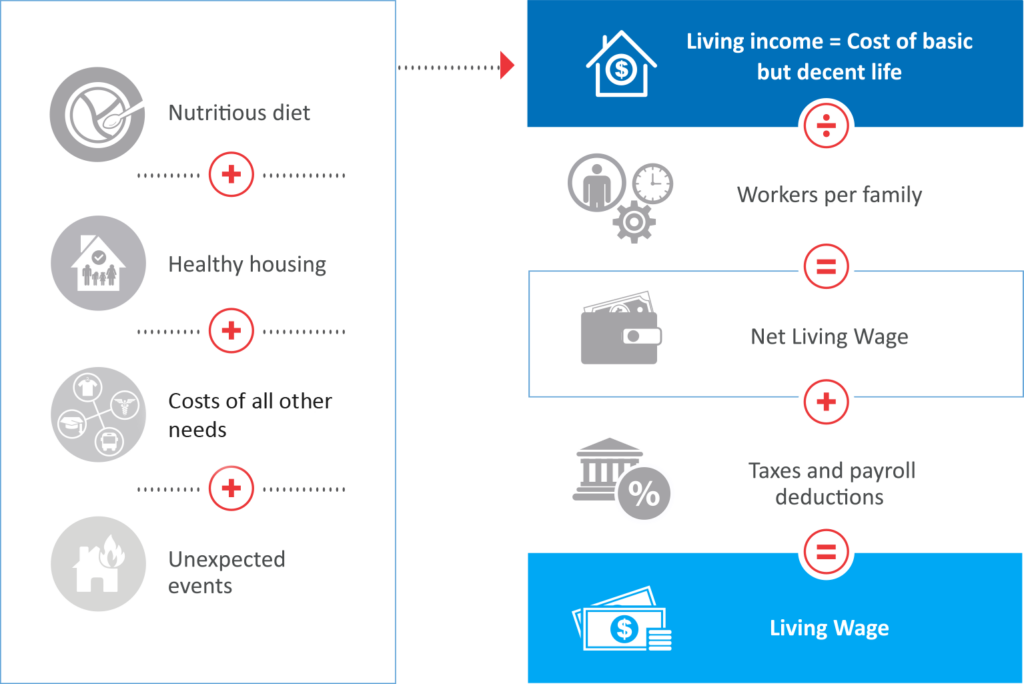A Shared Approach to Estimating Living Wage
The GLWC believes that alignment around living wage definitions and measurement, and around living wage values themselves, provides a critical foundation for informing and enabling collaborative efforts to raise worker wages. The Coalition is committed to using the Anker methodology as the basis for producing high quality, consistent, objective information about living wages and wage gaps to support wage improvement strategies and programmes. The methodology was developed by Richard and Martha Anker, who head the Anker Living Wage and Living Income Research Institute. The Coalition is also committed to supporting the further development and application of this methodology.
Background
This methodology has been used to estimate living wages in nine countries for a multi-national corporation while it was being developed and has now been used to estimate living wage for over 30 additional locations globally for the GLWC, with strong uptake and interest among both local and international stakeholders.
You can learn more about this methodology on our FAQ page and on the Anker Research Institute website.
Access the full methodology (e-book).
Definition of Living Wage
The GLWC members have agreed to the following definition of living wage. This definition succinctly incorporates the main characteristics of living wage found in over 60 living wage descriptions and definitions from human rights declarations; national constitutions; NGO, multinational, and corporate codes of conduct; ILO documents; and statements of major historical figures such as Popes and the Catholic Church (Anker 2011).
A living wage is:
Remuneration received for a standard work week by a worker in a particular place sufficient to afford a decent standard of living for the worker and her or his family. Elements of a decent standard of living include food, water, housing, education, health care, transport, clothing, and other essential needs, including provision for unexpected events.
Methodology for Measuring Living Wage
The living wage methodology has two main components. The first component estimates cost of a basic but decent lifestyle for a worker and his/her family in a particular place. The second component determines if the estimated living wage is being paid to workers.
Several aspects of this methodology are new and groundbreaking. First, the methodology emphasizes participation of local people and organisations in order to increase its credibility and acceptance by stakeholders. Second, housing costs are estimated using international and national standards for decent housing. By estimating the cost of decent housing, the methodology enables different living wage estimates within countries and helps ensure that workers can afford decent housing.
Third, the methodology requires transparency and detailed documentation and analysis to ensure that the living wage estimate is solid and credible. This includes critical appraisal of available secondary data and adjustments to these data when required. Fourth, a judicious combination of new local data collection and available secondary data is used to make the methodology simultaneously practical and credible. Thus, local food prices and housing costs are collected as are education, health care, and transportation costs to make sure that workers are paid enough to afford these necessities.
Finally, the estimation of living wage is explicitly separated from the determination of whether particular workers receive a living wage or particular employers pay a living wage. The evaluation of wage levels by certification bodies requires considering not only gross cash payment, but also deductions from pay, overtime pay, bonuses, and in-kind benefits.
Estimating the Cost of a Basic but Decent Lifestyle for Workers and Families
Figure 1 depicts how the methodology works. In the first step, living costs are divided into three categories: food, housing, and other essential needs.
- Food costs are estimated based on: (i) a low cost nutritious diet that meets World Health Organization (WHO) recommendations on calories, macronutrients, and micronutrients and is consistent with local food preferences and a country’s development level; and (ii) local food prices for the types, qualities, and quantities of foods that workers typically buy based on new data collection that involves workers and key informants. This approach to the model diet uses a more stringent nutrition standard than the typical approach at present, which ensures only a sufficient number of calories. By collecting local food prices with worker input, realistic food prices are obtained that mimic workers’ food shopping habits and preferences.
- Housing costs are estimated using international (UN-HABITAT) and national standards for decency (e.g. dwellings located outside slums and unsafe areas that have permanent walls, roofs that do not leak, and adequate ventilation; amenities such as electricity, water, and sanitary toilet facilities; and sufficient living space so parents can sleep separately from children). The cost of acceptable housing is based on visits to local housing with workers.
- Lastly for practical reasons, cost of all other needs is estimated using an extrapolation method based on secondary household expenditure data. This is because we believe that people should have full control over how they use their income and we should not decide for them what is or is not an acceptable expenditure. This is then “post checked” to make sure that sufficient funds are included for health care, education, and transportation. This guards against the extrapolation method replicating poor living conditions as it is based on currently observed expenditure according to available household expenditure data.
Total cost per capita of a basic but decent standard of living is then scaled up to arrive at a cost for a typical family size in the area. A small margin is then added to provide for unexpected events and emergencies such as illnesses and accidents, to help ensure sustainability and avoidance of the perpetual poverty trap. To arrive at the living wage estimate, the estimated total cost of a decent standard of living for a typical family is then defrayed over the typical number of full-time equivalent workers per family for that location.

Figure 1. Methodology for estimation of living wage
This methodology is a practical compromise between separately estimating cost of each and every expense families have, and the most common approach currently used for estimating living wage in developing countries, which uses just two expense groups (food costs based on a model diet and nonfood costs based on secondary data). Using normative standards for decent housing and estimating housing costs separately (not as part of nonfood costs, as in typical methodologies) ensures that living wage estimates enable workers to afford decent housing. In contrast, typical methodologies rely on available expenditure data to estimate housing costs and so replicate current (often substandard) housing conditions. Our methodology also better allows for different living wage estimates for rural and urban areas, as housing costs are usually the most important cause of differences in living costs. Our methodology also increases transparency, because the size of the “all other essential costs” bucket is much smaller and examined more thoroughly (and adjusted when necessary) than in typical approaches.
Determining if a Living Wage is Being Paid
To determine if a worker receives a living wage, the methodology takes into account how workers are paid. For example: (i) overtime pay is excluded because living wage needs to be earned in standard working hours; (ii) productivity bonuses and allowances are excluded unless they are guaranteed; (iii) mandatory taxes are taken into consideration because sufficient disposable income is required so workers can afford a decent living standard; and (iv) fair and reasonable value for in-kind benefits provided is taken into consideration, because in-kind benefits reduce the amount of cash income workers need for a decent living standard. However, since too great a reliance on non-monetary benefits hinders empowerment and free choice, the methodology includes rules on how to value in-kind benefits to ensure that their value is fair and reasonable. The methodology also include guidances on how to check wage levels in different labour situations (e.g. standard employment, temporary or seasonal labour, piece rate).
Involvement of Local Stakeholders
The process of estimating a living wage for a particular location involves consultation with and the participation of local stakeholders, including trade unions and employer organisations when present. The goal of the estimation process is to obtain a credible living wage estimate that stakeholders are likely to view as legitimate and reasonable regardless of whether or not local employers feel they can pay this living wage. Local stakeholders are closely involved in the collection of local food and housing costs, based on visits to workers’ homes and places where workers shop for food; workers provide information on local preferences and living conditions; employers and workers provide information on in-kind benefits, bonuses, and deductions from pay; and, before final conclusions are taken, stakeholders are asked to provide feedback and suggestions on preliminary living wage estimates.
Testimonials
The manual could serve as the basis for an applied Master’s course in development economics. It belongs on the shelf of every development practitioner, where it would sit confidently alongside classics like Gittinger’s (1982) Economic Analysis of Agricultural Projects.”
– African Journal of Agricultural and Resource Economics
Anker and Anker have delivered a substantial, practically-minded resource for helping to establish living wage standards in nations and regions across the world, and which should be of vital interest to all those interested and engaged in this battle as it continues to advance.”
– British Journal of Industrial Relations
This book is a substantial achievement, and evidence of a research project with the potential to make a real difference to the world.”
– Citizen’s Income Newsletter
Overall, Living Wages around the World: Manual for Measurement looks set to become a well-thumbed reference guide for researchers, governments/policy analysts, international organisations, NGOs, and community groups interested in a deeper understanding of living wage standards and policies. This book is likely to stoke a developing and important dialogue over what constitutes equitable, meaningful, and relevant pay around the globe.”
– Labour & Industry
The Global Living Wage Coalition is seen as a global leader in assessing living wage thresholds.”
– Future-Fit Business Benchmark





